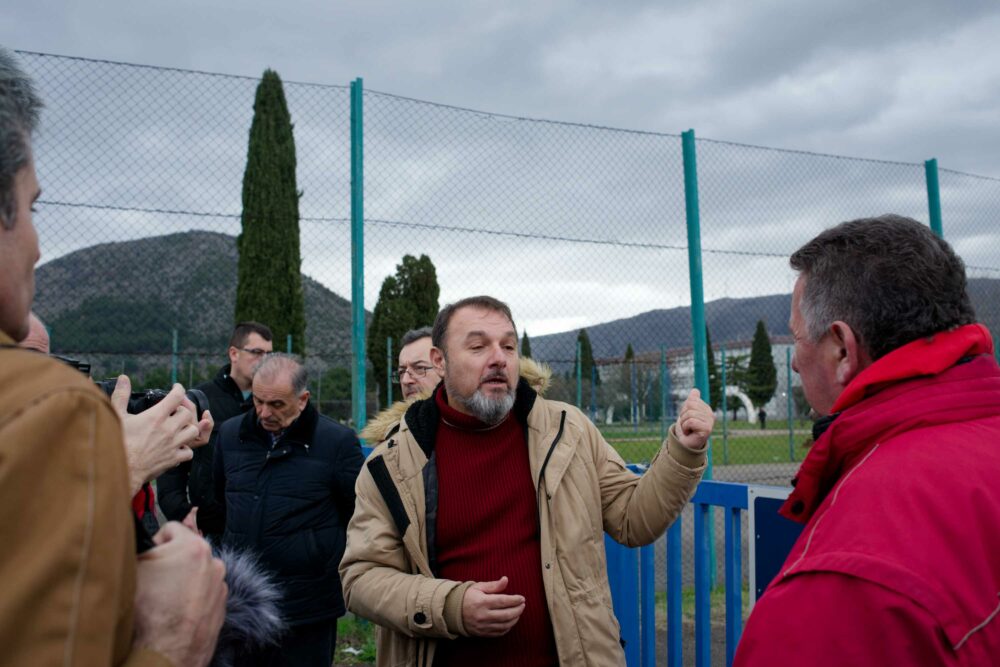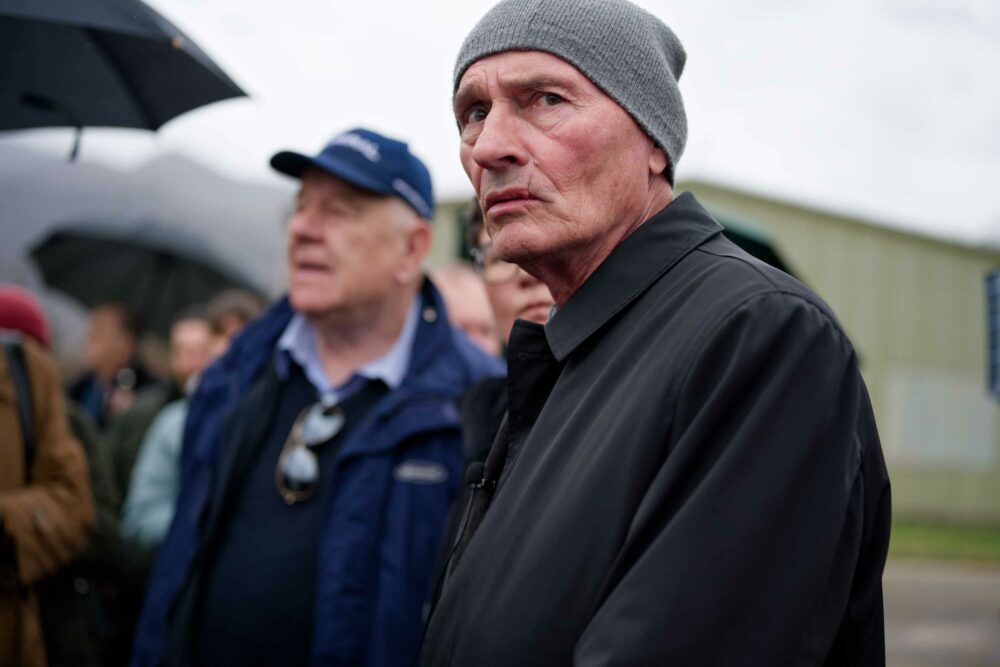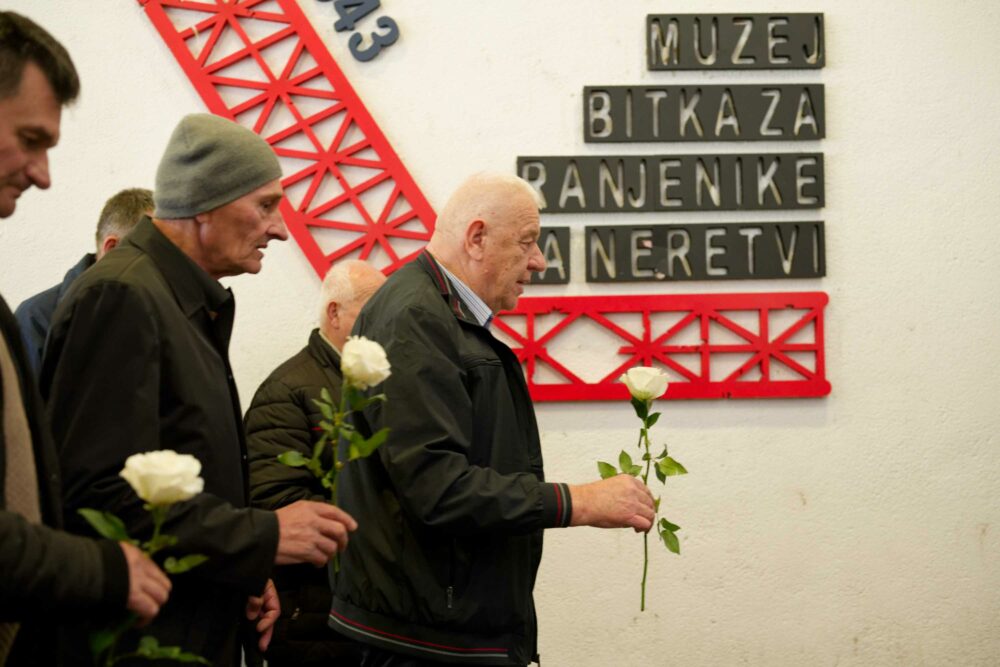Together with prison camp survivors, supported by peace activists, reporters and war veterans, from 9 to 11 March 2024, the Centre for Nonviolent Action visited former detention facilities in the area of Konjic – Čelebići barracks, Mostar – Heliodrom in Rodoč, Istočni Mostar – former primary school in Zijemlje, and Jablanica – Museum of the Battle for the Wounded on Neretva.
Since 2015, the Centre for Nonviolent Action has also been implementing actions to mark unmarked sites of suffering in BiH. The barracks in Čelebići, Heliodrom in Mostar, the former school in Zijemlje and the Museum of the Battle for the Wounded on Neretva have been recognised as detention sites in several judgements from the ICTY, the Court of Bosnia and Herzegovina and other courts in BiH, and several people have been convicted of crimes committed at these locations. To date, none of these sites have been marked, but more information about them and the related trials is available on the site for Marking Unmarked Sites of Suffering in BiH.
In addition to the fact that many sites of suffering, including detention facilities, have not been marked to this day, former prisoners, survivors and families of those who were killed are often prevented from accessing these sites. The Centre for Nonviolent Action issued a press release stating that a joint visit to sites like these is also an appeal to the authorities, especially those at the local level, to provide support for victims fighting for the right to memory, instead of presenting obstacles, to allow unimpeded access to the locations, as well as the permanent marking of such sites.
The Mostar Prison Camp Survivors Association is fighting for access by prison camp survivors to Heliodrom and other former detention sites in the Mostar area. Unfortunately, access was once again denied, the former camp building is not marked as a detention site, while at the same time there are plans for a museum dedicated to HVO. According to survivors’ testimony, some 10,000 people had passed through this camp, of which 6,000 were from Mostar.
“People were detained here, boys and men aged 5 to 86 and women of various ages. We wrote to the Ministry of Defence of Bosnia and Herzegovina to express our opposition to constructing a museum at any site where a war crime as determined by the courts was committed. In our letter we said, imagine if we as Bosniaks wanted to build a museum of ARBiH in Čelebići, which we just visited. It would be desecration of the victims, it would be offensive, it would be the worst form. In our opposition to the construction of this museum, which will apparently be built by a joint effort of BiH and Croatian authorities, we are saying that this constitutes a post-war crime. A new crime is being committed. As a Bosniak, I cannot accept this, I cannot agree with it, and I can only say that I feel shame over the crimes committed by members of ARBiH, in Grabovica for instance, or anywhere else. We from the Mostar Prison Camp Survivors Association sent an initiative to the Croatian Prison Camp Survivors Association of Mostar for us to go together to Grabovica to lay flowers and to come here to Heliodrom. Unfortunately, even though people would personally like to do this, they don’t dare because of politics. We are the only association in the whole of Herzegovina that is not under any political control. No one likes us, no one cares about us, simply because as victims we are unwanted on all sides. That is why to this day there is no law on civilian war victims at the level of BiH. We are united in our suffering, and they, the politicians, they are united in their crimes!”, said Edin Batlak, a prison camp survivor from Mostar.
The visit to former sites of detention in Herzegovina was joined by prison camp survivors, war veterans and peace activists from Mostar, Rogatica, Zavidovići, Konjic, Sanski Most, Rudo, Derventa, Žepče, Fojnica, Livno, Sarajevo, Novi Grad/Bosanski Novi, Doboj, Prijedor, Šamac, Goražde, Bihać, Brčko, Bugojno, Belgrade, Paraćin, Čačak, Kruševac, Prilep, Skopje, Požega, and Zagreb.
Slobodan Mrkajić who lives in Rogatica today was imprisoned from May 1992 to mid-1994 in the area of Konjic, Mount Igman and Hadžići. Today, he is the president of the Prison Camp Survivors Association of the Sarajevo-Romanija Region and president of the assembly of the Prison Camp Survivors Federation of Republika Srpska. Coming to Čelebići, where he had been imprisoned for several months, was particularly emotional for him.
“The suffering here was horrific. There was rape, torture, beatings, abductions, missing persons, some people have still not been found. In the hangar behind me, I was held there with another two, actually with relatives. Let me just repeat once more so you know what happened here, it cannot be put into words. They tell me I should write a book, I can’t, every 24 hours would be a book of 200 pages, it’s impossible to write, impossible to convey, only the other prison camp survivors who are here with me now understand, only those who went through the same horrors… Any one of them, we all have the same stories and we see eye to eye. It was the same treatment, as if following the same recipe, see they’re nodding their heads…” Slobodan Mrkajić said, standing in front of the hangar where he was imprisoned with other members of his family, including his father.
In 1993 and 1994, Marinko Ljoljo was imprisoned for several months in the basement of the Museum of the Battle for the Wounded on Neretva. To date, the Museum has not been marked as a detention site, but on 1 March each year, an official commemoration is organised in front of the Museum to mark the liberation of the last prisoners and the disbanding of the camp.
“Almost no one has been held responsible for establishing the camp, which was formed by the local authorities and the military leadership. Many of the perpetrators have died in the meantime. Two persons are serving prison sentences, and several others are on trial for mistreatment of prisoners of war. No one is talking about the civilian victims. The prosecutor’s office keeps turning a blind eye and a deaf ear and remains mute at our insistence that the indictments need expanding. No one likes prison camp survivors, they are unwelcome in their communities as witnesses and as victims,” said Marinko Ljojo, remembering his days of being imprisoned at the Museum of the Battle for the Wounded on Neretva.
The Centre for Nonviolent Action Sarajevo – Belgrade (CNA) has sought to contribute to building an inclusive, non-selective culture of memory in BiH in various ways: by researching sites of suffering and sites of memory for the database and website kulturasjecanja.org; by publishing “War of Memories”; putting on the “War of Memories” exhibition that has toured the region over several years; through programmes of non-formal education aimed at enhancing social capacities for peacebuilding; through exchanges and learning from the experiences of other countries, and by systematising gathered information and knowledge; as well as through joint commemorative actions of war veterans from BiH, Croatia and Serbia.
“Unfortunately, to this day, almost 30 years after the war, with a few honourable exceptions, selective empathy only towards victims belonging to one’s own people is the dominant approach, both in BiH and across region. Over these two days, we came together with people of good will from all sides and visited four former detention facilities, demonstrating that a different, a joint approach to memory is possible. We are grateful to these people, to all people of good will who are prepared to come together and visit sites of suffering, to stand together in calling for these sites to be marked, to pay their respects to all victims. We know that we cannot make up for the lives lost and the suffering endured, but we want to do everything in our power to build relations of mutual respect and trust that will stand as a dam against the threat of hatred among people from different communities serving as grounds for new injustices and violence in the future. I regret to say that despite months of back-and-forth, the University of Mostar and the Museum of the Battle for the Wounded on Neretva did not allow us access to former detention facilities. We are particularly saddened by the fact that these are two public institutions whose primary role is education and that they are in various ways denying the suffering and pain of people who were imprisoned at these sites,” said Tamara Zrnović from the Centre for Nonviolent Action.
The photo gallery is available HERE
Video: HERE
Media links:
Bosnia and Herzegovina
Detektor, Dnevni avaz, Radio Konjic, Klix.ba, Hayat, Etto.ba, Start, BUKA, Mreža za izgradnju mira, FENA,ONASA, Inmedia, Dnevni ba, FACE BA, Direktno ba, Novikonjic.ba, HRVATSKO NEBO, HIP BA, Republika info
Montenegro
Serbia
Croatia:
Germany:


